Prodigal Daughter is an incredibly limp piece of television.
Prodigal Daughter plays more like a first season episode than a final season episode, the result of a creative process where the writing staff are still trying to figure out how best to approach major characters and even how best to structure individual episodes of the series. There is something distractingly amateurish about Prodigal Daughter, which seems to largely consist of one-shot guest characters standing around drab sets talking about things that happened off-screen. It is not so much bad as it is boring.

Painting a pretty picture.
To be fair, there are reasons for these problems. Ezri Dax was still a new character, and the production team were still getting to grips with her. Although Ezri had been integrated into the ensemble with relative ease, the writers had only given her a single character-focused episode in Afterimage. This was understandable, with everything else going on, but it meant that the character still had to find a unique voice. Beyond that, the structural problems with Prodigal Daughter were largely down to nightmarish disorganisation behind the scenes.
Of course, knowing this does not make it any easier to watch Prodigal Daughter.

Oh, brother!
Introducing a new character into an existing ensemble is a challenge. Look at Star Trek: Voyager. The character of Seven of Nine had been introduced as a new member of the primary cast in Scorpion, Part II and very quickly usurped many of the supporting players. Starting with The Gift, it seemed like almost every other episode was in some way about Seven. Primary plots in The Raven, Prey, Retrospect, The Omega Directive, One, Hope and Fear; secondary plots in Day of Honour, Revulsion, The Killing Game, Part I and The Killing Game, Part II.
To be fair, it is possible to smoothly integrate a new character into an existing cast. Star Trek: Deep Space Nine did it with Worf during the fourth season. However, the writers working on that introduction had an advantage. By that point, the audience was already very familiar with Worf. The character had appeared in seven seasons of Star Trek: The Next Generation and its feature film spin-off Star Trek: Generations. As such, there was no need to push him to the front of the line for character focus or development.
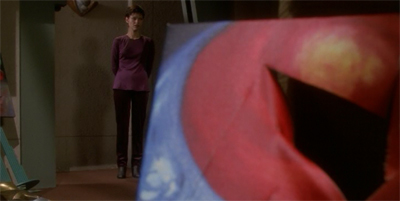
Shred no tears.
However, these potential problems are compounded when a new character is added in what should be the final season. The final season of a television show should be largely given over to resolving lingering plot threads and wrapping up character arcs. Attempting to do that while also adding a new character who must start (and presumably finish) their arc within that season is a very daunting challenge. The writers not only have to figure out who this character is, they also have to figure out where they are going and how to get there.
Writers ask these questions of every character, but they generally have more time to figure it out. After all, it took the writers on Deep Space Nine three full seasons to figure out how to write for Julian Bashir and Jadzia Dax, struggling through episodes like The Passenger, Melora and Meridian in the process. Indeed, many of the character traits that define the lead characters were not defined for the first few years of the series. Joseph Sisko is a key figure in the mythos of Deep Space Nine, but Sisko talked about his father as if he were dead in episodes like The Alternate.
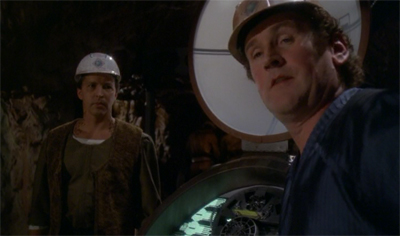
Chief concerns.
So Ezri Dax presented a challenge to the production team. In Special Crew Dossier: Ezri Dax, Ira Behr talked about the challenges of introducing Ezri so late in the run:
It’s very tough in the last year, because (a.) you’re thinking so much about the end of the series, and (b.) you’re so busy worrying about, ‘Well, we don’t want to repeat ourselves.’ So to have this new character suddenly come on, who’s not a new character, because she’s still Dax, was just such a wonderful thing for us, because it was like, ‘Oh, we know what to do with that. We could give you twenty stories with that.’ We had to cut back on those stories because we didn’t want to have the cast up in arms about just doing Ezri Dax stories. Because she brought so much baggage with her, from Jadzia, it was like, ‘Oh, we can play in that pond for weeks.’
It was an opportunity, but it was also a massive risk. More than that, because of the limited space available to tell stories about Ezri Dax, there was no margin of error.
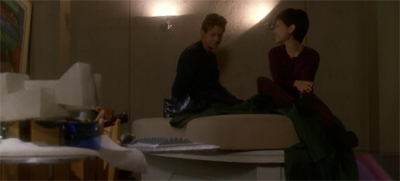
Bro escape.
When building up a new character, it makes sense to focus on their families and their history, to provide audiences with a sense of where these characters are coming from. There are plenty of examples within the Star Trek franchise of early episodes focusing on relatives and extended family members of the primary cast. Spock’s father drops by in Journey to Babel. Data discovers a brother that he never knew he had in Datalore. Riker’s father shows up The Icarus Factor. Sato interviews Reed’s parents in Silent Enemy. Mayweather visits his family in Horizon.
(Paradoxically, family was also a convenient storytelling crutch for late season episodes. The final season of The Next Generation seemed to be populated by characters related to the primary cast; LaForge’s family were the focus of Interface, Data found his long-lost mother in Inheritance, Picard came face-to-face with a man who might have been his son in Bloodlines, Troi discovered her deceased sister in Dark Page, Worf confronted his adopted brother in Homeward and a future version of his son in Firstborn, Crusher buried her grandmother in Sub Rosa.)
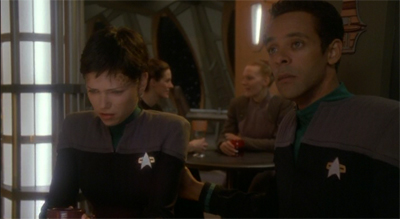
Gagh reflex.
Star Trek did not have the strongest track record when constructing stories about relatives of the primary cast. Very few of these relatives tended to be recurring characters. When the writers on The Next Generation introduced Worf’s son in Reunion, they struggled with how best to approach his character. (The story Time’s Orphan was originally developed as a way to potentially write Alexander out of the show.) When the writers on Deep Space Nine reintroduced Alexander in Sons and Daughters, they promptly wrote him back out in You Are Cordially Invited…
To be fair, Deep Space Nine tends to do better with extended family members than the other Star Trek show. The bond between the three generations of the Sisko family was compelling enough to support the seventh season premiere, Image in the Sand and Shadows and Symbols. There was something deeply affecting in the portrait of the dysfunctional Bashir family presented in Doctor Bashir, I Presume. Indeed, Quark’s journey back home to confront his domineering mother made for compelling family drama in Family Business.
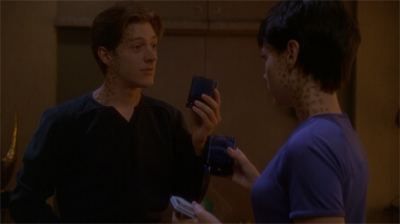
Family fun.
It should be noted that none of these dynamics worked on the first draft. Joseph Sisko was a relatively late addition to the mythos, with dialogue as early as Emissary suggesting that Benjamin Sisko’s father was deceased. Similarly, the versions of Richard and Amsha Bashir who appeared in Doctor Bashir, I Presume are radically different from the characters suggested through exposition in Melora. Quark’s family underwent a similar evolution. The version of Rom who becomes Nagus in The Dogs of War is unrecognisable compared to the iteration in The Nagus.
As such, an episode focusing on the extended family of Ezri Daz is inherently a risky proposition. The absolute best case scenario is that the audience is invited to spend forty-five minutes with a bunch of well-drawn and well-developed characters who are unlikely to ever appear again. It could easily feel like a distraction from character and plot arcs in which the series is already invested. After all, the bulk of Prodigal Daughter unfolds on Sappora VII. Most of the cast are sidelined for the episode. Quark and Worf do not appear at all.
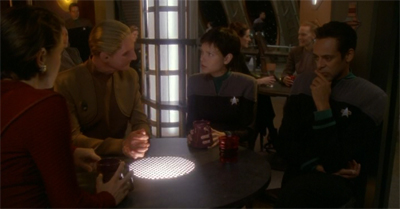
Obligatory regular cast appearance.
To be fair, there is some interesting material here. Deep Space Nine has only superficially explored Trill culture in episodes like Invasive Procedures, Equilibrium and Rejoined, but it has defined the alien society as one built around established class structures. It is a culture built around the concept of social mobility, the idea that individuals can be elevated to a higher social class by “joining” with symbionts that are functionally immortal. This has created a dysfunctional society, in which a lot of the political and cultural power is invested in a minority of individuals.
Conventionally, class narratives tend to focus on families. After all, historically speaking, entrenched class structures were traditionally rooted in family units. This is most obvious in the very notion of aristocracy, when land and title would pass from one generation to the next. It is also reflected in the idea of monarchy as a system of government, the idea that an individual is more worthy to rule because of their bloodline. Less dramatically, the rules of inheritance mean that wealth and influence is likely to be passed from parent to child in some capacity.
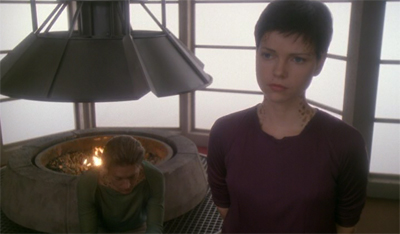
Home fires.
As such, it might be interesting to explore the rigidly structured Trill society through the prism of family. If social mobility on Trill happens through the process of “joining”, what about traditional indicators of social class? Is there some correlation between those who are elevated through “joining” and those that come from powerful families? Does the notion of social class exist beyond the influence of the symbionts? Is Trill society so topsy-turvy that the process of “joining” has effectively usurped the traditional role of the family unit as a buttress of class structure?
Prodigal Daughter makes a few token gestures at these potentially interesting questions in its opening few minutes. Most overtly, it is made very clear that Ezri comes from a fairly wealthy and powerful family, one that is very much invested in the capitalist systems that exist beyond the Federation. The Tigan family owns “the fifth largest pergium mining facility in the entire sector.” Certainly, their mining operations appear impressive. However, there are also indications of their decaying social influence.

All mine.
Most obviously, the Tigan operation seems to exist on the fringe. Yanas and her family do not live on Trill, or even within the Federation. They operate in lawless space, in a region of the galaxy where the Orion Syndicate operates with impunity. Yanas still travels to Trill, visiting her daughter there after the joining, but she seems to exist at a remove from her own culture. When Ezri reminds her that it is traditional for the host to take the name of the symbiont, Yanas coldly responds, “I haven’t been away from Trill that long.”
It is interesting to wonder whether the Tigan’s family circumstances are in linked to the fact that Ezri is the only member of the family who has any personal experience with the symbionts. Even that was by accident. Episodes like Invasive Procedures and Equilibrium suggested that there were large portions of the Trill population that would never experience joining, while episodes like The Host and Emissary seem to suggest that joined Trill occupy prominent places in the Trill social hierarchy. Are families of the unjoined forced to look outside Trill for opportunities?
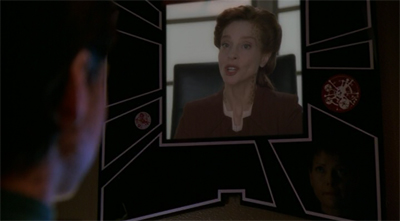
Mother knows best.
That introductory conversation between Ezri and Yanas reinforces the idea that the process of joining is supposed to supplant family and elevate the host beyond their roots. “The symbiont name always replaces the family name of the new host,” Ezri reminds her mother. “It’s traditional.” Yanas responds, sounding almost resigned, “Of course it is.” How must it feel for a parent to lose their child in such a way? What must it be like for a family to know that their link with the host is symbolically shattered?
There is a lot of potentially interesting material here to explore, fertile ground for storytelling. After all, Ezri is distinct from Jadzia in many ways. Ezri was never prepared for joining. The seventh season has largely explored how the people who knew Jadzia are responding to Ezri, but there must be some drama in exploring how characters who knew Ezri Tigan respond to Ezri Dax. After all, in many ways, Ezri is a fundamentally different person than she used to be. How must that feel for her mother and her brothers?
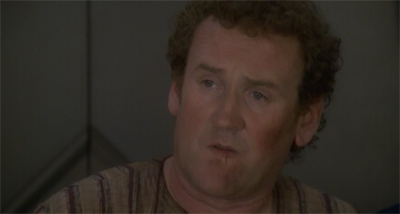
O’Brien must suffer.
Even if it has to happen off-screen.
Unfortunately, Prodigal Daughter bungles that particular plot by trying to jam it into another story that is completely different. On the one hand, Prodigal Daughter is a story about Ezri Dax returning home for the first time since she has been joined. On the other hand, it is written as a sequel to Honour Among Thieves, with Chief O’Brien embarking on a mission to New Sydney to investigate the mysterious disappearance of Morica Bilby, the widow of the criminal with which he forged a bond while working undercover.
As such, Prodigal Daughter is an Ezri-centric episode that also has to serve as an “O’Brien must suffer” episode, filling that particular storytelling niche for the seventh season. (There are also shades of “O’Brien must suffer” to Extreme Measures, but they are tied up in Section 31 and “O’Brien and Bashir buddy comedy” story.) In some ways, this speaks to the lack of space in the seventh season, leading the writers to jam certain stories together. The Emperor’s New Cloak would be an ungodly cocktail of a Ferengi episode and a mirror universe episode.

“It could be worse. We could be talking about next week’s episode.”
If this sounds like a mess from a creative standpoint, it was. Television production is an incredibly grueling job, especially after six long years. According to The Star Trek: Deep Space Nine Companion, the writers were up against a deadline as they worked on Prodigal Daughter:
With only days left before shooting was to begin, the writers were told to start over. To save time, they tried to keep whatever elements they could: the notion that Ezri was going home, and even that the family somehow was involved with the Orion Syndicate. But that would work only if they could find a viable reason. Behr suggested that bringing Miles O’Brien into the story would allow them to pay off the O’Brien/Bilby story from Honour Among Thieves, while at the same time giving them room to explore interpersonal dynamics at the Tigan homestead.
“Trying to marry those two stories was really difficult,” Moore says. “It was just a mess.” Moore speaks from firsthand knowledge. Because the writing staff was in a bind, he offered to help out, and went directly from his final draft of It’s Only a Paper Moon to helping out Weddle and Thompson with Prodigal Daughter. “The show was already in prep,” he notes, “so it was a case of ‘First though, best thought.’ Just throw it down and move on, because we’ve gotta get ten pages out today. So boom! You just blaze through it.”
In television production, it is vitally important to have scripts for the production team to shoot. There can be no delays. The production cannot be halted. Writing for television in this situation is very much a “do or die” situation. And Prodigal Daughter is a prime example of that pressure.
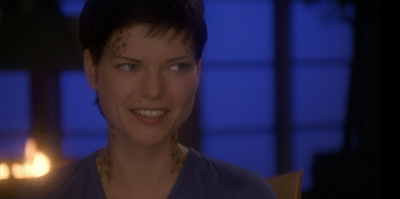
The production of Prodigal Daughter in a nutshell.
Prodigal Daughter is an episode that often feels like it has the basic ingredients of a story, but the writers do not have time to assemble them in a way that makes sense. There are two competing narratives here, one focusing on Ezri and one focusing on O’Brien. The finished episode feels like it combines the worst aspects of either narrative. Prodigal Daughter is an episode overburdened with exposition, populated by characters who spend more time recounting the plot to one another than forwarding the narrative.
Consider where Prodigal Daughter starts. Morica Bilby has been murdered by Norvo Tigan, the culmination of an elaborate blackmail scam concocted by the Orion Syndicate who infiltrated the mining organisation when Janel Tigan needed a favour. However, none of this is actually shown. Instead, these individual elements are all introduced as small mysteries, and them resolved through a fairly static exposition dump in the fourth-to-last scene of the episode.

Picture perfect.
To be entirely fair, it is possible to construct a compelling story in this fashion. In the Pale Moonlight is structured as an elaborate confession by Sisko. The Visitor opens with an older version of Jake Sisko. However, both of these stories jumped back to depict the events that the characters were discussing. Whispers is a mystery built around a major left-field reveal that comes only in the final minutes of the episode. The Pegasus is an episode about Riker dealing with a shameful secret from his history.
The problem with Prodigal Daughter is that all of the major characters in this story are one-shot guest characters. Morica Bilsby never appears on-screen. Norvo and Janel will never appear again. The audience have no investment in any of these characters before the story begins, which means that the episode has to effectively make a case for the audience to invest in these characters. However, Prodigal Daughter doesn’t have the time or the energy, burying their relationships in underdeveloped mysterious and broad innuendo before an exposition-laden climax.
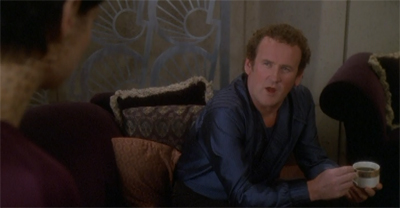
Miles from home.
This problem is compounded by the fact that Prodigal Daughter invests most of its energy in developing Yanas Tigan as a character. Yanas is the member of the Tigan family who has the strongest sense of identity, who has the clearest sense of motivation and perspective. Yanas is presented as a domineering mother, and she dominates the episode. It helps that she is played by Leigh Taylor-Young, the strongest of the guest cast. Neither Norvo nor Janel step outside her shadow, which makes it hard for the audience to really accept the climactic revelations.
Prodigal Daughter effectively reduces Ezri and O’Brien to witnesses to the aftermath of a family drama. O’Brien doesn’t actually do anything. In fact, his even his brutalisation happens off-screen before his first appearance in the episode. Similarly, Ezri acts like a passenger in the third act of some half-baked family psychodrama. Despite her intimate knowledge of these people, it seems like the audience can work out that Norvo killed Morica a few lines before Ezria realises that anything is wrong. (“He didn’t do it,” Norvo states of his brother, something only the killer could know.)
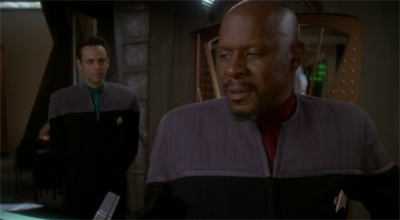
“Doctor, consider yourself lucky I don’t assign you to the primary plot.”
Again, Deep Space Nine has built compelling stories about guest characters. Dukat was the focus of Indiscretion and Return to Grace, with Kira effectively along for the ride. Martok anchored Soldiers of the Empire and Once More Unto the Breach, with Worf as an observer. Weyoun took centre stage in Treachery, Faith and the Great River, although Odo also had an arc in that episode. Prodigal Daughter follows on directly from It’s Only a Paper Moon, an episode centred on Nog and Vic Fontaine.
However, these characters were all recurring players who had developed over several episodes before taking centre stage, and who were played by actors who understood the workings of the franchise. The characters in Prodigal Daughter are all relatively two-dimensional, feeling more like roughly-sketched archetypes rather than fully-formed characters. Norvo is an artist who is ill-suited to the work that his mother has assigned him. Janel is not a capable business man, despite his best efforts. These are outlines of characters, they are not enough to support an episode.
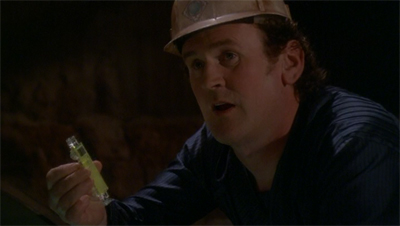
“That’s not a plot device. THIS is a plot device.”
To be fair, Prodigal Daughter seems at least aware for this central problem. At certain points, the script tries to give Ezri and O’Brien some material to play, allowing them to appear proactive instead of reactive. However, these moments are fleeting and overblown. At one point, O’Brien discovers evidence of a connection between the Tigan family and Morica Bilby. “What’s going on here?” he suddenly demands of Ezri. “Did you come here to find me or to prevent me finding out the truth?”
That is one hell of an accusation to make, especially considering the relationship between Ezri and O’Brien. “She’s my superior officer,” O’Brien told Janel. “I go when she goes.” It should take a lot for a Starfleet officer to accuse their superior of complicity in a murder. It might make sense for O’Brien to lash out if he were tired or defeated, like when he lashed out at Bashir in Hard Time. However, Prodigal Daughter never quite sells that idea. It is not so invested in O’Brien’s perspective that the audience has a sense of what he has been through.
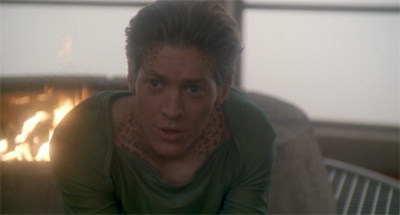
… Norvo the battle to the strong.
Similarly, it might make sense if O’Brien were skeptical of Ezri to begin with. After all, Ezri is something of a stranger to O’Brien. She is somebody who just showed up, claiming to have the memories of a person that he had known for years. It would be completely in-chracter had Worf voiced these suspicions, given his established attitude towards the latest Dax host. However, there is never any sense that O’Brien is at all uneasy with Ezri. After all, it was O’Brien who had the big talk with Worf in Afterimage about learning to accept Ezri.
That discussion feels like an awkward attempt to shoehorn some conflict between major characters into the episode, as if to ensure that Nicole deBoer and Colm Meaney are still awake. Prodigal Daughter is an episode that yearns desperately for an emotional connection to the audience, but which ultimately feels flat and hollow. It is the flip-side of Deep Space Nine‘s quieter character-driven family studies like Family Business or Doctor Bashir, I Presume, attempting the same sort of intimate family drama but failing awkwardly.
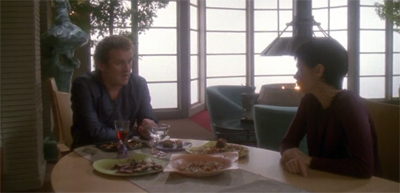
“Now let’s never speak of this again.”
The worst thing about Prodigal Daughter is not the muddled plot or the flat characters or the exaggerated attempts to generate drama. The most damning thing about Prodigal Daughter is just how boring it is.
Filed under: Deep Space Nine | Tagged: drama, Ezri Dax, o'brien must suffer, prodigal daughter, star trek: deep space nine |




















I can’t find it in myself to hate “Prodigal Daughter” because it is one of those stories that has quite a bit of potential and which made under impossible circumstances. I get the feeling that if the production team hadn’t had to film what was basically a first draft, and had instead possessed the time to revise & fine-tune it, then it might have turned out, if not great, then at least fairly good.
Also, it does feel like Nicole de Boer is doing her very best to keep the wheels from flying off of this one.
However, one thing that really annoyed me was O’Brien stating that Ezri was his superior officer. How the hell is that possible? O’Brien has been in Starfleet for over two decades, and Ezri for maybe a year. I admit that I have little familiarity with military command structures, but it just seems bizarre that Ezri would outrank O’Brien. (I can’t imagine that the experiences of the Dax symbiote would count towards seniority.)
Um, maybe that was supposed to be the major “O’Brien must suffer” element of this episode, having it revealed that he’s outranked by an inexperienced Junior Lieutenant who is half his age? I know that I’d be embarrassed if that happened to me!
To be fair, I think that O’Brien and Nog joke about this quirk of Starfleet hierarchy in Favour the Bold, when Nog gets promoted to ensign. I don’t know enough about military ranks to know if these conversations are accurate.
And, yeah, I’m sympathetic to this big mid-season slump. In fact, it’s amazing that Chimera works out as well as it does, given it was part of this mid-year clusterf**k.
DS9 never really could figure out where O’Brien fell in the hierarchy. On paper, he’s a Senior Chief Petty Officer- that makes him an NCO, a senior enlisted man (WO2 in British terms). On the other hand he is also “senior staff,” included in “senior officers” meetings, hosts parties in the wardroom (strictly commissioned officers’ country in RW navies), and, above all, orders ensigns (= commissioned officers) around as if they’re his subordinates. It’s possible that some writers on the show confused two different meanings of “Chief” in naval parlance, mucking up “Chief Petty Officer” with “Chief Engineer” (a position properly held by Lt-Commanders Scott and LaForge in the earlier series).
Moore (who attended Navy ROTC) would later get things like this straight in Battlestar Galactica.
I concur with Ben. Trill episodes are often weak but this ended up being one of the stronger ones. It’s always nice to see O’Brien out of his element (though the wonderful thing about Colm is that he always looks out of place on Star Trek) and he and Ezri have a good rapport.
We never really got to experience Jadzia’s adjustment as a joined trill (putting aside the stilted acting in the beginning, which was retconned as Emory’s influence). Jadzia’s family is another question mark so this is a compelling answer.
The “twist” with Fredo…I mean Norvo is pretty pathetic. If Norvo didn’t want to run the business, he would have just let it go bankrupt. Which ended up happening anyway.
I actually don’t mind the Trill episodes too much. Invasive Proceedures is flawed, but fun. Equilibrium is intriguing, Facets has a lot of good bits, and Rejoined is legitimately good. None of them are world-beaters, and there are a few duds in there – Dax is dull, and Playing God is at best competent – but they’re not too terrible. I’d put Prodigal Daughter and Field of Fire near the bottom of the proverbial pack.